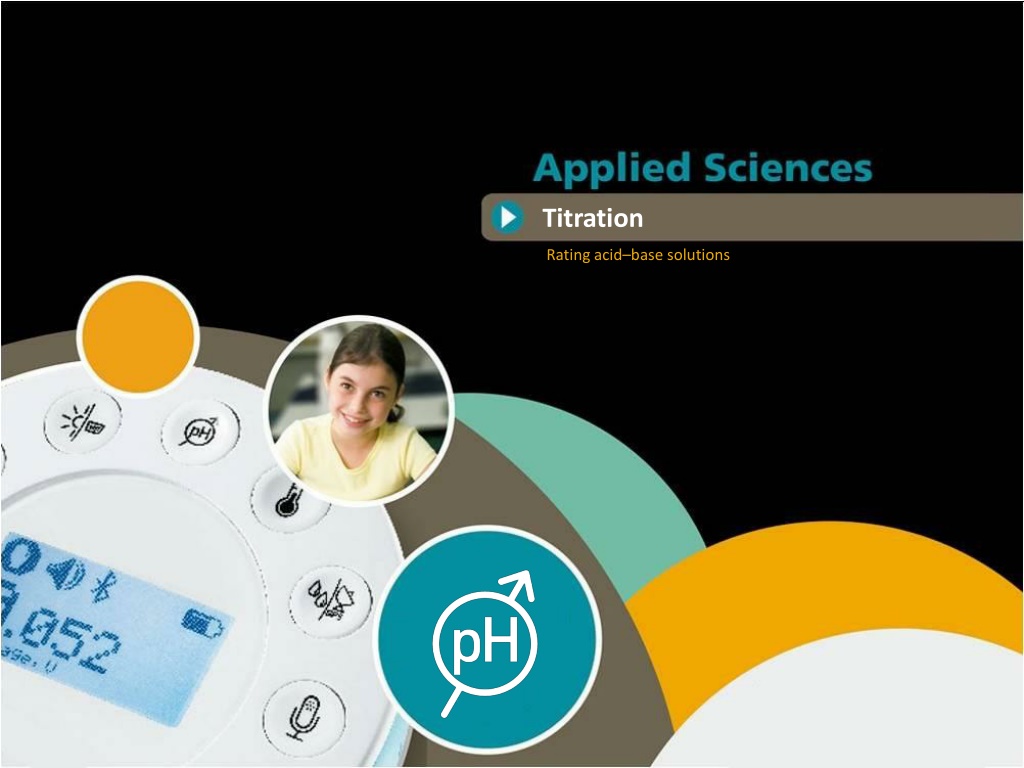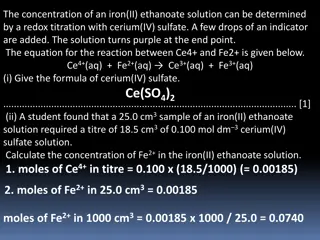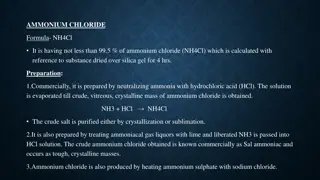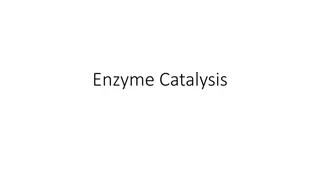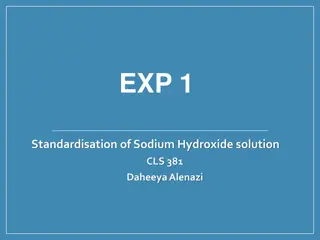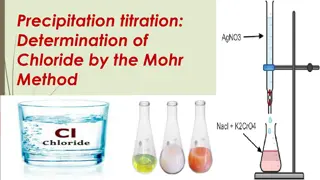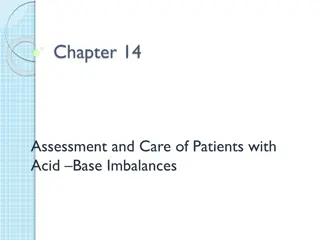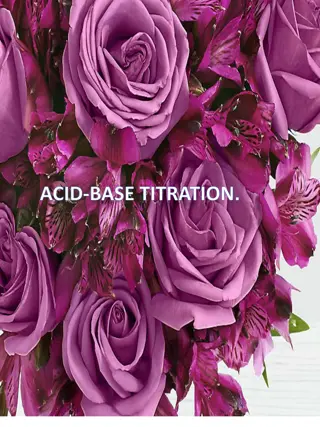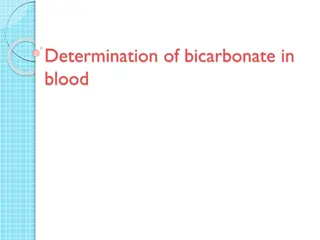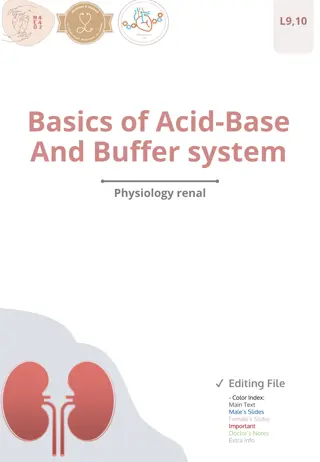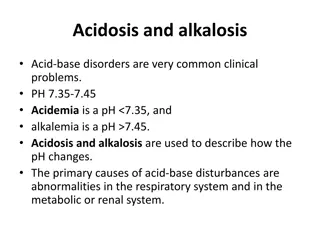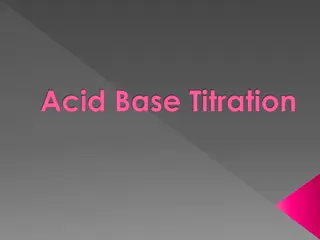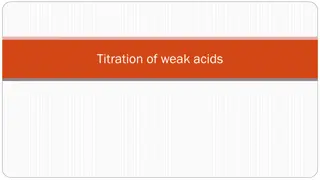Understanding Acid-Base Titration in Chemistry
Acid-base titration is a quantitative technique used to determine the concentration of an unknown acid or base solution. By neutralizing the solution with the opposite component and reaching the equivalence point, students can calculate the concentration using stoichiometry principles. This method dates back to the 18th century and continues to be a fundamental aspect of analytical chemistry, aiding in hypothesis testing and verifying concentrations through the use of pH sensors.
Download Presentation

Please find below an Image/Link to download the presentation.
The content on the website is provided AS IS for your information and personal use only. It may not be sold, licensed, or shared on other websites without obtaining consent from the author. Download presentation by click this link. If you encounter any issues during the download, it is possible that the publisher has removed the file from their server.
E N D
Presentation Transcript
Titration Rating acid base solutions
Titration Rating acid base solutions Objective The purpose of this activity is to use the technique of acid-base titration to find the concentration of a strong acid of unknown concentration, through hypothesis formulation and verification, using the SensorLab built-in pH sensor.
Titration Rating acid base solutions Introduction and theory Titration is about neutralization and balance. Base and acid solutions neutralize each other. When we don t know if a material is acid or base, we add the opposite component until it is neutralized. The amount that was added indicates the concentration of the original solution. The first experiments in titration can be found as far back as the late eighteenth century where volumetric analysis was taking place in France . At this time scientists were exploring analytical chemistry, with the very first burette made by Francois Antoine Henri Descroizilles. By 1824 Karl Freiderich Mohr advanced the cylindrical burette to the lab tool we recognize and use today with a clamp at the bottom.
Titration Rating acid base solutions Introduction and theory How important is it for chemistry to determine the concentration of the reagents with which they work? What does the concept of concentration refer to? What kind of units are used to be measured?
Titration Rating acid base solutions Introduction and theory Theoretical As mentioned, titration is a quantitative technique used to find the concentration of an acid or a base of unknown concentration. When performing an acid-base titration what happens is a chemical reaction. The general chemical equation representing a reaction of a strong acid with a strong base is: ( ) ( ac OH ac H + + ) ( ) H O l 2 When analyzing the equation, it can be deduced that if a strong acid is reacted with the stoichiometric amount of a strong base, water (pH = 7) is produced. When it reaches this point (where the pH of the solution is neutral), it is at the equivalence point, i.e. when the resulting solution is neutral. As a result there will be an amount of moles of acid equivalent to the amount that have moles of base.
Titration Rating acid base solutions Introduction and theory Based on this, thanks to the stoichiometry you can calculate the concentration of an acid or base of unknown concentration. Since knowing the number of existing moles in a solution and its volume you could calculate the concentration. For the experiment you should consider the balanced chemical equation to be used: + + ( ) ( ) ( ) ( ) HCl ac NaOH ac NaCl ac H O l 2
Titration Rating acid base solutions Introduction and theory Now students are encouraged to raise a hypothesis which must be tested with an experiment. If you had a strong acid solution and you would like to know its concentration, how could you do it?
Titration Rating acid base solutions Activity description Students will perform an acid-base titration to determine the concentration of a hydrochloric acid solution using the SensorLab built-in pH sensor. Then they will build a graph exporting data to Excel. Here they can obtain the data necessary to calculate the concentration of the strong acid. The results obtained can be compared with the hypothesis.
Titration Rating acid base solutions Resources and materials pH electrode USB cable NaOH 0,1 N HCl 0,1 N (problem solution) Phenolphthalein Burette 100 ml 150 ml beaker NOTE: The HCl solution is of an unknown concentration students, as it will be revealed by performing the experiment. Universal support for Gloves
Titration Rating acid base solutions Resources and materials Distilled water Dropper Absorbant paper Magnetic stirrer 100 ml graduated cylinder Wooden gripper
Titration Rating acid base solutions Using the SensorLab SensorLab configutarion To make measurements with the pH sensor, the SensorLab must be configured by following these steps: Open the GlobiLab software and turn on the SensorLab. Click the Bluetooth icon in the lower right corner of the GlobiLab screen. Select the SensorLab you are currently using. Once the SensorLab has been recognized by the software, the icon will change from gray to blue . If you prefer a USB connection, follow the previous instruction by clicking on the USB icon. You ll see the same change in color when the SensorLab is recognized .
Titration Rating acid base solutions Using the SensorLab Click Enter "Manual" for the sampling frequency. to set the SensorLab. Select pH in the window "Logger Setup".
Titration Rating acid base solutions Using the SensorLab Once you have finished configuring the sensor, start measuring by pressing . Whenever you want to record a sample press . Once you have finished measuring, stop the SensorLab by clicking .
Titration Rating acid base solutions Experiment Assemble the montage as shown in the figure. Put 40 ml of test solution of HCl in the beaker and add five drops of phenolphthalein. Fill the burette with 100 ml of 0.1 N NaOH. Add 1 ml of NaOH and HCl, and as the measurement stabilizes record the sample. Every time you take data, write how much total volume of NaOH has been added.
Endothermic and exothermic reactions Titration Performing different measurements to examine which reactions release or consume heat. Rating acid base solutions Experiment Experiment When you appreciate a slight discoloration of the solution in the precipitate cup, add small amounts of NaOH (dropwise). At that time you will be equilibrium point (pH = 7). Please record the pH and see what the solution of the precipitate vessel looks like. very close to the After the solution has been neutralized, keep adding NaOH until the pH no longer varies. You can keep adding larger volumes (being 1 and 5 ml).
Titration Rating acid base solutions Electrode maintanance Washing and caring for the electrode The pH electrode is very sensitive and requires some care including: After each measurement wash the sensor tip with distilled water. It is therefore important to have a squeeze bottle. If you do not have a squeeze bottle, you need a minimum 10 ml syringe to wash the SensorLab electrode.
Titration Rating acid base solutions Electrode maintanance After each wash with distilled water, the sensor should be dried with absorbent paper, WITHOUT TOUCHING the transparent ball which is at the tip of the electrode. Each time the sensor is not in use, the electrode must be kept within the buffer, which corresponds to the solution vile standing on the electrode tip (do not forget that the sensor should be previously washed and dried according to points 1 and 2).
Titration Rating acid base solutions Results and analysis Indicate in the graph the equilibrium point with the the corresponding moments. tool at After that, show the value of the neutralized solution with the tool. Finally, export the data to Excel by pressing the Conduct a pH chart v / s volume of NaOH added in ml. button.
Titration Rating acid base solutions Results and analysis How did the pH increase before and after the point of balance? What happened in the graph at the point of balance, and what could be observed in the beaker? With how much volume of NaOH can the solution be neutralized?
Titration Rating acid base solutions Results and analysis The graph below should be similar to the one the students came up with:
Titration Rating acid base solutions Results and analysis The graph below should be similar to the one the students came up with from Excel:
Titration Rating acid base solutions Conclusions At how much volume of NaOH was the solution neutralized, how many moles of NaOH werethereat a certain volume? It is intended that students indicate the volume of NaOH used to neutralize the HCl, and through the NaOH concentration they can calculate the amount of moles added to HCl. What concentrationdid the problemsample of HCl have? It is intended that students using the titration chemical reaction equation are able to deduce that the amount of added moles of NaOH to neutralize the HCl were equivalent to the moles of HCl in the sample. As the initial volume of HCl is known, it is possible to calculate its concentration.
Titration Rating acid base solutions Activities for further application How would the solution in the beaker taste when the pH is 7? The aim is for students to understand that when the chemical reaction between HCl and NaOH are in stoichiometric amounts, water and NaCl is formed. Accordingly, it would be perceived as salty taste. If you had a test sample of NaOH, and you wanted to know the concentration and the HCl were not available, what solution would you use to figure it out? Justify your answer. The aim is for students to understand that in class they worked with a strong acid (HCl) and strong base (NaOH). Therefore, to perform titration, any strong acid would be required.
